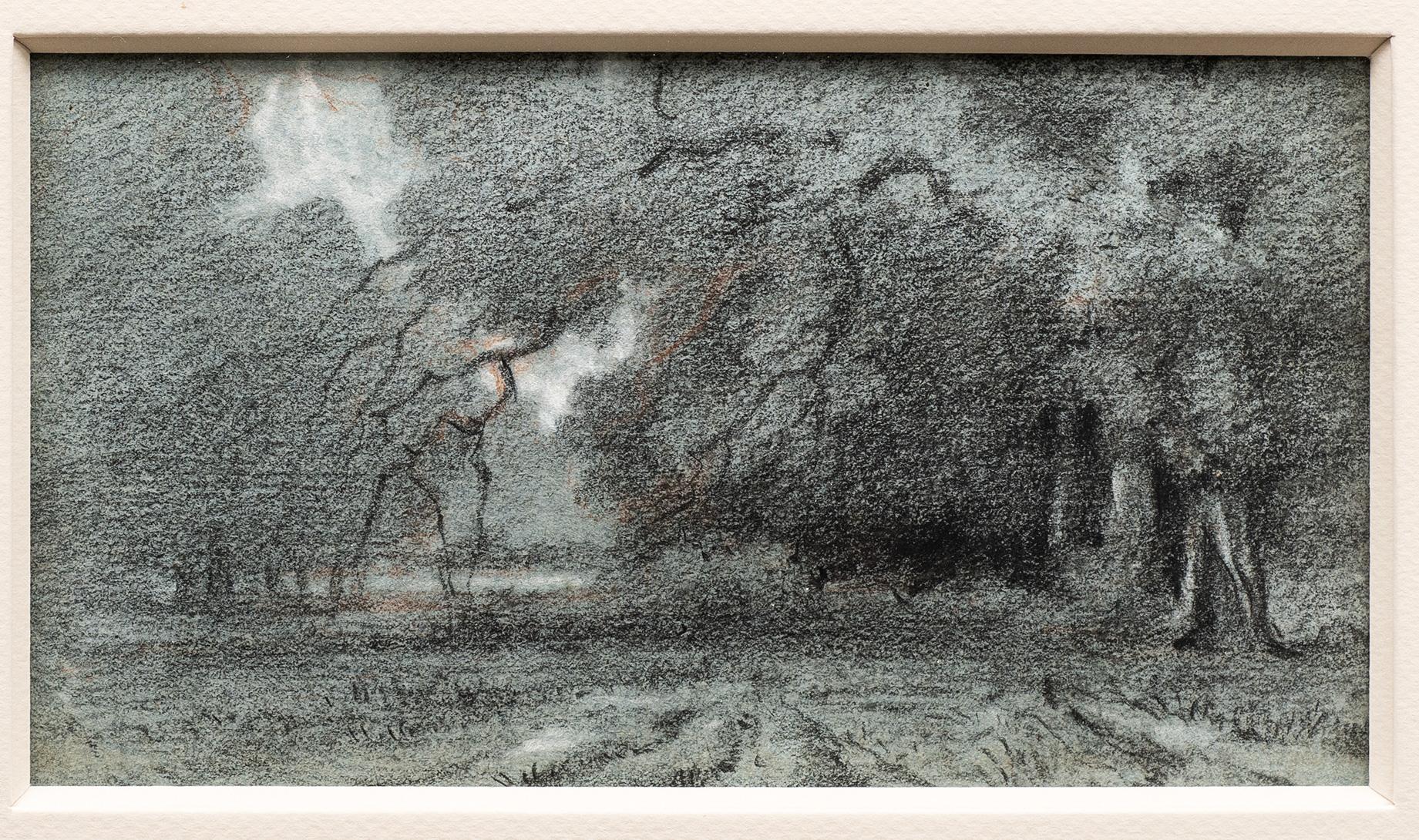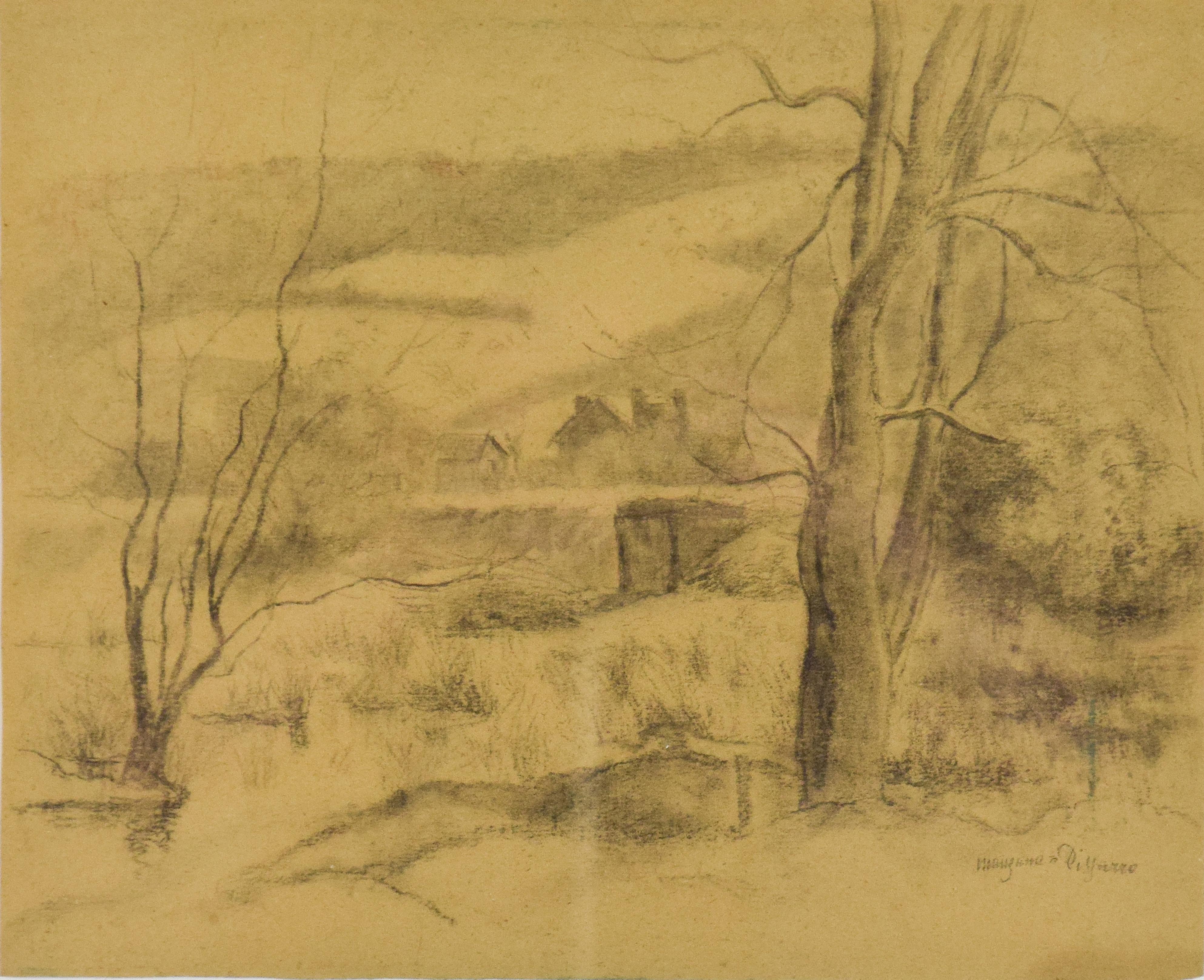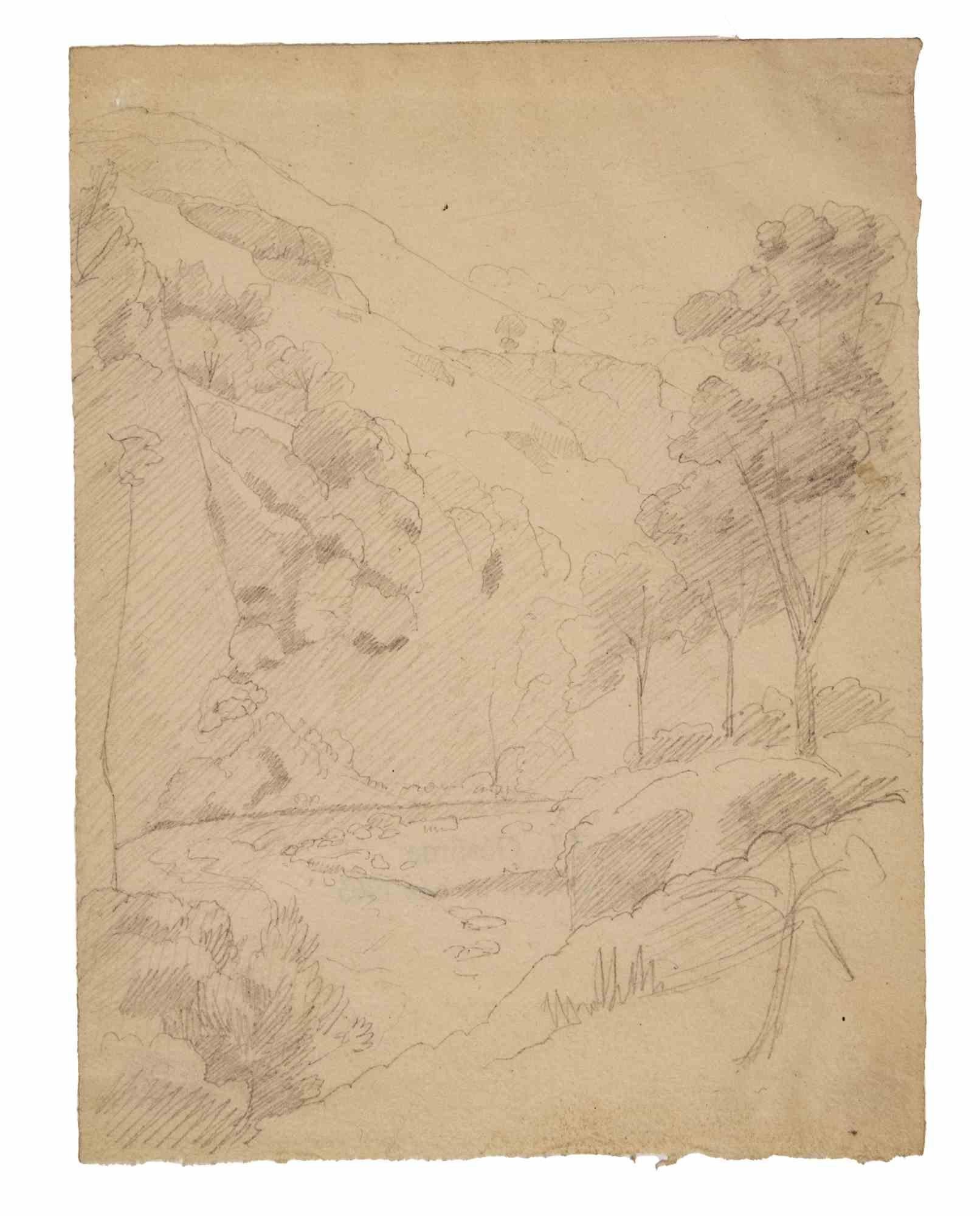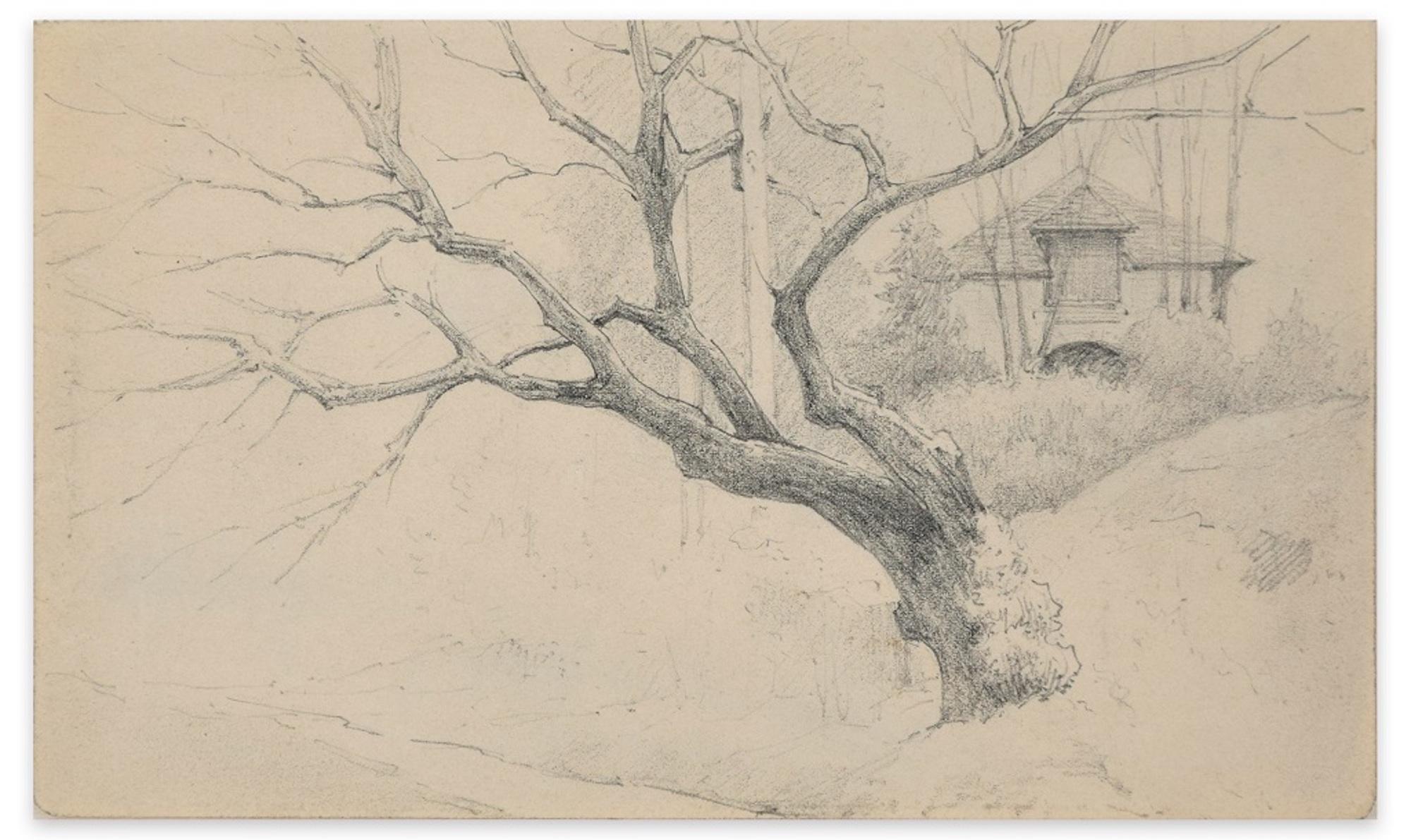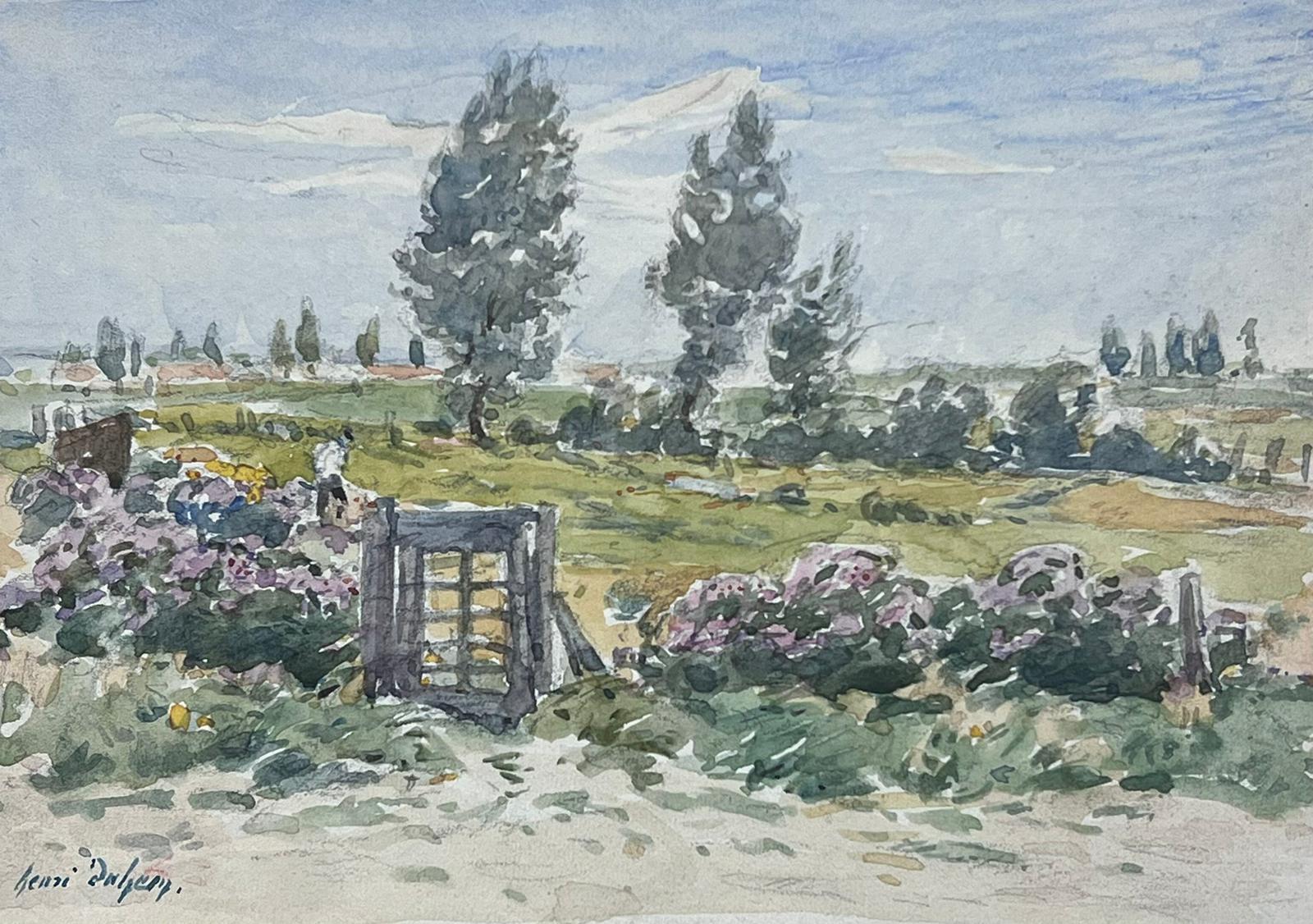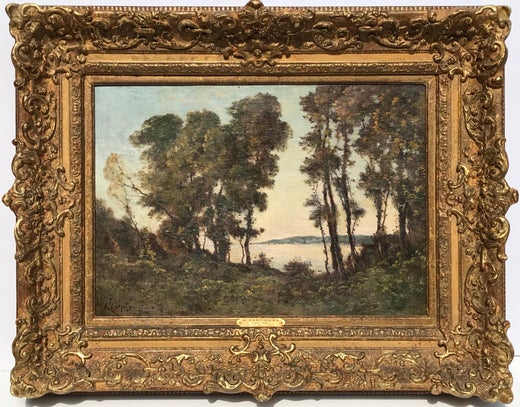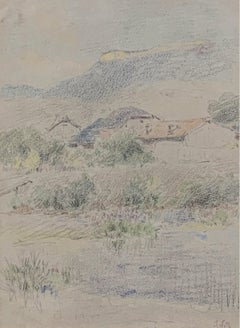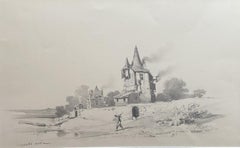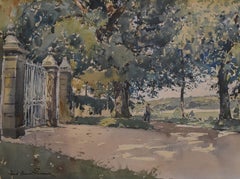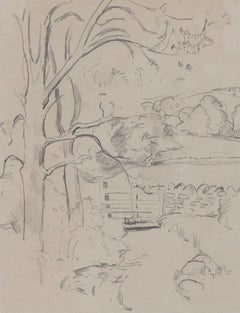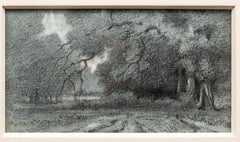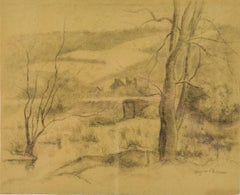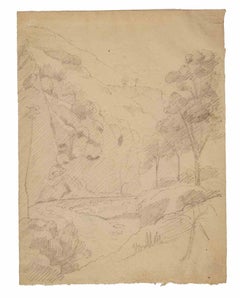Items Similar to Henri Harpignies (1819-1916) A Barrier on the hedge, study, signed drawing
Video Loading
Want more images or videos?
Request additional images or videos from the seller
1 of 10
Henri Joseph HarpigniesHenri Harpignies (1819-1916) A Barrier on the hedge, study, signed drawingcirca 1860
circa 1860
$852.42
£637.36
€720
CA$1,193.79
A$1,312.43
CHF 678.42
MX$15,704.10
NOK 8,564.86
SEK 8,029.80
DKK 5,484.91
About the Item
Henri Harpignies (1819-1916)
A Barrier on the hedge, study
Signed lower left, annotation "branches séchées sur la barrière" (dried branches on the fence) on the upper right
Charcoal and heightenings of white chalk on grey paper
19,6 x 22.5 cm
Framed : 30 x 36.3 cm
This drawing is particularly moving and interesting, as it gives us an insight into the artist's work. It is indeed a study, as we can see how Harpignies was interested in this barrier, which must have charmed him, to the point of including the detail of the stone that serves as its counterweight at the top of the sheet. But above all, it's a very accomplished drawing, with those beautiful white highlights that testify to Harpignies' commitment.
By developing and nurturing this landscape, he shows how the barrier motif serves as an anchor for the landscape that separates the foreground from the distant, wooded background.
He undoubtedly found it during a walk and lingered on this picturesque motif. Here we are at the heart of the art and work of this generation of plein-air painters of the Barbizon school, so attached to the countryside.
Henri Joseph Harpignies, born in Valenciennes (Nord) and died in Saint-Privé (Yonne), was a French landscape painter, watercolorist and engraver of the Barbizon School.
Henri Joseph Harpignies’ parents intended him for a commercial career, but his determination to become a painter led them to allow him to enter Jean Achard’s studio in Paris in 1846. After two years’ training, he travels to Italy.
Back in France in 1850, Henri Harpignies devoted himself to children’s bambochades in landscapes, joining Corot and the Barbizon School, who were to inspire him. A close friend, the two artists made a trip together to Italy in 1860.
In 1859, he collaborated on the decoration of the staff room at the Hôpital de la Charité in Paris, partially rebuilt in the Assistance Publique – Hôpitaux de Paris museum.
On his return from Italy in 1861, he achieved his first success at the Salon. He then exhibited regularly at the Salon. In 1866, he received his first medal for Le Soir dans la campagne de Rome, acquired by the State.
Over the course of his very long career, Henri Harpignies painted a large number of works in the center of France. He produced decorative works for the Paris Opera, including the Val d’Égrie panel, which he exhibited at the Salon in 1870. He was a friend of Léon Bonnat, who painted his portrait twice in 1889 (Musée des Beaux-Arts de Valenciennes and Petit Palais in Paris)
He painted the stained-glass windows of the Château de Trousse-Barrière in Briare in 1895. In 1898, he was named Honorary Rosati.
He won numerous awards. Medals at the Paris Salon in 1866, 1868 and 1869. Second-class (silver) medal at the 1878 Universal Exhibition. Medal of honor in 1897 for Solitude et Bords du Rhône.
In 1875, he was named chevalier, then promoted to officer (1883), commander (1901) and grand officer (1911) of the national order of the Legion of Honor.
He was buried in the Saint-Privé (Yonne) cemetery.
Anatole France described him as "The Michelangelo of trees and peaceful countryside."
Works by Harpignies are held in numerous museums :
• Paris, Le Louvre ; Musée du Petit Palais ; Musée d'Orsay
• Lille, palais des Beaux-Arts : Vue prise à Moncel-sur-Seille (Meurthe-et-Moselle), vers 1868
USA
• New York, Metropolitan Museum of Art: Paysage avec une ville au loin
• Tulsa, Philbrook Museum of Art : Pont ferroviaire sur la Briare.
• Washington, National Gallery of Art : Paysage en Auvergne.
Canada
• Montréal, Musée des beaux-arts de Montréal : Clair de lune (1889)
• Québec, Musée national des Beaux-Arts du Québec : Paysage
Argentina
• Buenos Aires, National Museum of Fine Arts
- Creator:Henri Joseph Harpignies (1819-1916, French)
- Creation Year:circa 1860
- Dimensions:Height: 7.49 in (19 cm)Width: 10.63 in (27 cm)
- Medium:
- Movement & Style:
- Period:
- Condition:
- Gallery Location:Paris, FR
- Reference Number:Seller: Inv 7871stDibs: LU1112215677622
Henri Joseph Harpignies
Henri Joseph Harpignies was born in Valenciennes on June 28, 1819 and died in Saint-Privé onAugust 28 1916 He was a French landscape painter , watercolourist and engraver of the Barbizon School . Henri Harpignies' parents, Henri and Adèle, intended him for a commercial career, but his determination to become a painter led them to authorize him to enter Jean Achard 's studio in Paris in 1846. After two years of training, he left to travel to Italy .
Returning to France in 1850, Henri Harpignies joined Corot and the Barbizon School, whose influence he came under. Bound by friendship, the two artists traveled to Italy together in 1860.
In 1859, he collaborated in the decoration of the staff room of the Charité hospital in Paris.
On his return from Italy in 1861, he achieved his first success at the Salon with his Lisière de bois sur les bords de l'Allier . He then exhibited regularly at the Salon. In 1866, he received his first medal for Le Soir in the Rome campaign, acquired by the State . He then lived at 185, rue du Faubourg-Saint-Honoré in the 8th arrondissement of Paris before moving to 9, rue Coëtlogon .
During his very long career, Henri Harpignies painted a large number of works in Hérisson in the Bourbonnais , as well as in the Nivernais and Auvergne . He made decorative works for the Paris Opera , including the Val d'Égrie panel , which he exhibited at the Salon in 1870. He was a friend of Léon Bonnat , who twice made his portrait in 1889 ( Musée des Beaux-Arts). He painted the stained glass windows of the Château de Trousse-Barrière in Briare in 1895. In 1898, he was named Rosati d'honneur .
Anatole France called him “the Michelangelo of trees and peaceful countryside” .
At the end of his life, he was nearly blind.
He is buried in the cemetery of Saint-Privé ( Yonne ) .
His works are held in numerous ublic collections :
Such as Landscape with a City in the Distance (c.1865), watercolor, New York , Metropolitan Museum of Art .
Montreal Museum of Fine Arts : Moonlight (1889)
National Museum of Fine Arts of Quebec : Mountain landscape
Tulsa , Philbrook Museum of Art : Briare Railroad Bridge .
Washington , National Gallery of Art : Landscape in Auvergne .
Buenos Aires , National Museum of Fine Arts : The Briare Canal Lille , Palace of Fine Arts : View taken at Moncel-sur-Seille (Meurthe-et-Moselle)
About the Seller
5.0
Gold Seller
Premium sellers maintaining a 4.3+ rating and 24-hour response times
Established in 2018
1stDibs seller since 2019
257 sales on 1stDibs
Typical response time: <1 hour
- ShippingRetrieving quote...Shipping from: Paris, France
- Return Policy
Authenticity Guarantee
In the unlikely event there’s an issue with an item’s authenticity, contact us within 1 year for a full refund. DetailsMoney-Back Guarantee
If your item is not as described, is damaged in transit, or does not arrive, contact us within 7 days for a full refund. Details24-Hour Cancellation
You have a 24-hour grace period in which to reconsider your purchase, with no questions asked.Vetted Professional Sellers
Our world-class sellers must adhere to strict standards for service and quality, maintaining the integrity of our listings.Price-Match Guarantee
If you find that a seller listed the same item for a lower price elsewhere, we’ll match it.Trusted Global Delivery
Our best-in-class carrier network provides specialized shipping options worldwide, including custom delivery.More From This Seller
View AllMarie Joseph Clavel dit Iwill (1850-1923) Landscape with a village, signed
By Marie-Joseph Iwill
Located in Paris, FR
Marie Joseph Clavel dit Iwill (1850-1923)
Landscape with a village,
signed lower right
color pencils on paper
27 x 18.5 cm
In good condition, a stain visible in the upper left corner
in a modern frame : 40.5 x 32.5 cm
This delicate landscape drawn with coloured pencils shows how the artist is trying out a technique that brings him closer to pointillism, here he is part of the contemporary post impressionist movement. A rare work and particularly interesting in this respect.
Marie-Joseph Léon Clavel was the son of Frédéric Clavel (1822-1902), an economist and philanthropist, and Amélie Philippe (1822-1904). He learned painting from Emmanuel Lansyer and Karl Joseph Kuwasseg.
Spending part of his childhood in Nancy, he finished his studies at the Lycée Bonaparte in Paris. In order to satisfy his father's plans, he began his active life in the trade.
In the early days of the 1870 war...
Category
Early 1900s Landscape Drawings and Watercolors
Materials
Color Pencil
Jules Noel (1810-1881) Landscape with a manor and a traveler, signed drawing
By Jules Noel
Located in Paris, FR
Jules Noel (1810-1881)
Landscape with a manor and a traveler
Signed lower left
Pencil on paper
27.5 x 44.5 cm
Framed under glass : 43 x 59.5 cm
This drawing shows more particularly...
Category
1860s Romantic Landscape Drawings and Watercolors
Materials
Pencil
Jules Noel (1810-1881) Landscape with a fisherman, signed drawing
By Jules Noel
Located in Paris, FR
Jules Noel (1810-1881)
Landscape with a fisherman,
Signed lower right
Pencil on paper
27.8 x 44 cm
Framed under glass : 43 x 59.5 cm
We find in this drawing everything that makes...
Category
1860s Romantic Landscape Drawings and Watercolors
Materials
Pencil
Paul Emile Lecomte (1877-1950) La Grille (The Gate), signed watercolor
By Paul Emile Lecomte
Located in Paris, FR
Paul Emile Lecomte (1877-1950)
La Grille (The Gate)
Signed lower left
Watercolor on paper
27 x 37 cm
In quite condition: yellowed by time, some stains
Framed: 43 x 53 cm
Paul Emile ...
Category
1930s Post-Impressionist Landscape Drawings and Watercolors
Materials
Watercolor
Edouard Dufeu (1836-1900) A Fantastic scene by a lake, signed drawing
By Edouard-Jacques Dufeu
Located in Paris, FR
Edouard Dufeu (1836-1900)
A Fantastic scene by a lake
Charcoal on paper
Signed lower right
23 x 30,5 cm
Framed under glass : 42.5 x 51 cm
This fantastic scene, the subject of whic...
Category
1880s Impressionist Landscape Drawings and Watercolors
Materials
Charcoal
Paul Lecomte (1842-1920) L'étang à Mortefontaine, signed watercolor
By Paul Lecomte
Located in Paris, FR
Paul Lecomte (1842-1920)
L'étang à Mortefontaine, an autumn landscape
signed lower left
Watercolor on paper,
29,3 x 22.5 cm
In its original vintage frame : 46 x 39,5 cm
titled on t...
Category
1880s Impressionist Landscape Drawings and Watercolors
Materials
Watercolor
You May Also Like
Landscape with Gate by Orovida Pissarro - Drawing
By Orovida Pissarro
Located in London, GB
Landscape with Gate by Orovida Pissarro (1893-1968)
Pencil on paper
25.7 x 20.4 cm (10 ¹/₈ x 8 inches)
Executed circa 1917
Artist biography:
Orovida Camille Pissarro, Lucien and Esther Pissarro’s only child, was the first woman in the Pissarro family as well as the first of her generation to become an artist. Born in Epping, England in 1893, she lived and worked predominantly in London where she became a prominent member of several British arts clubs and societies.
She first learned to paint in the Impressionist style of her father, but after a brief period of formal study with Walter Sickert in 1913 she renounced formal art schooling. Throughout her career, Orovida always remained outside of any mainstream British art movements. Much to Lucien's disappointment she soon turned away from naturalistic painting and developed her own unusual style combining elements of Japanese, Chinese, Persian and Indian art. Her rejection of Impressionism, which for the Pissarro family had become a way of life, together with the simultaneous decision to drop her famous last name and simply use Orovida as a ‘nom de peintre’, reflected a deep desire for independence and distance from the weight of the family legacy.
Orovida's most distinctive and notable works were produced from the period of 1919 to 1939 using her own homemade egg tempera applied in thin, delicate washes to silk, linen or paper and sometimes embellished with brocade borders. These elegant and richly decorative works generally depict Eastern, Asian and African subjects, such as Mongolian horse...
Category
1910s Post-Impressionist Figurative Drawings and Watercolors
Materials
Paper, Pencil
Pencil and Gouache Drawing of Fontainebleau Forest, France 19th century
Located in SANTA FE, NM
Drawing of Fontainebleau Forest
Barbizon, France
Pierre Auguste Brunet Houard (1829 - 1922)
19th century
Pencil, colored pencil, gouache, paper
8 x 4 1/2 (16 3/8 x 12 1/4 frame) inc...
Category
1860s Barbizon School Landscape Drawings and Watercolors
Materials
Gouache, Laid Paper, Pencil, Color Pencil
Paysage en Normandie by Georges Manzana Pissarro - Charcoal landscape
By Georges Henri Manzana Pissarro
Located in London, GB
Paysage en Normandie by Georges Manzana Pissarro (1871-1961)
Charcoal on paper
32 x 39 cm (12 ⅝ x 15 ⅜ inches)
Stamped lower right, Manzana Pissarro
Executed circa 1930
Artist biogr...
Category
1930s Post-Impressionist Landscape Drawings and Watercolors
Materials
Paper, Charcoal
Landscape - Etching by Jean-Léon Gérome - 19th Century
By Jean-Léon Gérôme
Located in Roma, IT
Landscape is a drawing realized by Jean-Léon Gérome (1824-1904).
Good condition on a yellowed pper, included a white cardboard passpartout (37.5x55 cm).
Stamp signed on the back of the little paper.
Jean-Léon Gérôme (11 May 1824 – 10 January 1904) was a French painter and sculptor in the style now known as academicism. His paintings were so widely reproduced that he was "arguably the world's most famous living...
Category
19th Century Modern Figurative Drawings and Watercolors
Materials
Pencil
Tree and House - Charcoal by E.-L. Minet - Early 1900
By Emile-Louis Minet
Located in Roma, IT
Tree and House is a precious pencil study realized by the French painter Emile-Louis Minet. The state of preservation is excellent. The piece of paper comes from a sketchbook, and it...
Category
Early 1900s Naturalistic Landscape Drawings and Watercolors
Materials
Charcoal, Pencil
Fine Antique French Impressionist Painting Country Landscape with Figure & Gate
Located in Cirencester, Gloucestershire
The artist:
Henri Aime Duhem (1860-1941) French *see notes below, signed
Title: The Country Landscape
Medium:
signed gouache on paper, loosely laid ov...
Category
19th Century Impressionist Landscape Paintings
Materials
Gouache
More Ways To Browse
Barbizon Frame
French Landscape Painter
Antique Montreal
Leon Bonnat
Clair De Lune
Painted Stained Glass Window
Antique Counterweights
Gretchen Guard Paintings
Gwyneth Johnstone
H A Dyer
Harold Lawes
Harold Phenix
India Street Scene
Jane Levy
John Carlisle
John William North
Louis Vuitton Recto Verso Black
Middle Eastern Antiques

